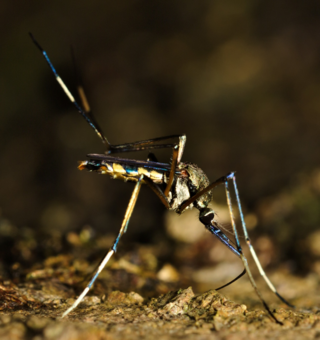
The Philippines, officially the Republic of the Philippines, is an archipelagic country in Southeast Asia. In the western Pacific Ocean, it consists of 7,641 islands, with a total area of 300,000 square kilometers, which are broadly categorized in three main geographical divisions from north to south: Luzon, Visayas, and Mindanao. The Philippines is bounded by the South China Sea to the west, the Philippine Sea to the east, and the Celebes Sea to the south. It shares maritime borders with Taiwan to the north, Japan to the northeast, Palau to the east and southeast, Indonesia to the south, Malaysia to the southwest, Vietnam to the west, and China to the northwest. It is the world's twelfth-most-populous country, with diverse ethnicities and cultures. Manila is the country's capital, and its most populated city is Quezon City. Both are within Metro Manila.
Francisco Edlagan Baisas was a Philippine entomologist regarded as the "Dean of Philippine Culicidologists" whose "contributions to the knowledge of Philippine mosquitoes is without measure". His passing was described as the end of "an era which saw the elucidation of the malaria vectors of the Philippines and great progress made in the control of a disease which had accounted for as many as 2,000,000 cases annually in those islands."

The Philippines national ice hockey team is the national men's ice hockey team of the Philippines. They are controlled by the Federation of Ice Hockey League (FIHL) and a member of the International Ice Hockey Federation (IIHF) since May 20, 2016. Prior to that period, a national team has played in regional tournaments in Hong Kong since the 2000s.
Aedes (Verrallina) butleri, sometimes as Verrallina butleri, is a species of zoophilic mosquito belonging to the genus Aedes. It is found in Sri Lanka Malaysia, Singapore, Java, Borneo, Philippines, Indochina, Thailand, and Maluku.
Aedes (Aedimorphus) pallidostriatus is a species complex of zoophilic mosquito belonging to the genus Aedes. It is found in Sri Lanka, Bangladesh, Malaysia, Thailand, India and Western Pakistan.
Aedes scatophagoides is a species complex of zoophilic mosquito belonging to the Mucidus Group of the genus Aedes.
Armigeres (Leicesteria) omissus is a species complex of zoophilic mosquito belonging to the genus Armigeres. It is found in Sri Lanka, India, Nepal, Indonesia, Malaysia, Taiwan, Thailand, Bangladesh, Philippines, Cambodia and China.
Hodgesia malayi is a species of zoophilic mosquito belonging to the genus Hodgesia. It is found in Sri Lanka, India, Malaya, Indochina, Philippines, Moluccas, Thailand, and Maluku.

Toxorhynchites (Toxorhynchites) splendens is a species of non-hematophagous mosquito belonging to the genus Toxorhynchites. It is widely used as a predator to control dengue mosquitoes.

Culex (Culex) gelidus is a species of mosquito belonging to the genus Culex. It is found in India, Sri Lanka, Bangladesh, Cambodia, China, Hong Kong, India, Indonesia, Japan, Laos, Malaysia, Myanmar, Nepal, New Guinea (Island); Papua New Guinea, Pakistan, Philippines, Taiwan, Thailand, Vietnam. In 1976, it was identified as a major vector of Japanese encephalitis virus, in India. From an experiment, it was evident that aqueous solution of Calotropis gigantea leaves possess larvicidal activity, mosquito repellent activity and ovicidal activity against Culex gelidus.
Culex (Lophoceraomyia) infantulus is a species of mosquito belonging to the genus Culex. It is found in Cambodia, China, Hong Kong, India, Indonesia, Japan, South Korea, Malaysia, Maldives, Myanmar, Nepal, Philippines, Sri Lanka, Thailand, and Vietnam.
Culex (Oculeomyia) infula is a species of mosquito belonging to the genus Culex. It is found in Bangladesh, India, Indonesia, Malaysia, Myanmar, Nepal, Philippines, Singapore, Sri Lanka, Thailand, and Vietnam. Adults mainly feeds on cattle but infrequently shows a low proportion of human and bird blood meals. Larvae can be found in water courses with high content of algal populations. In 1998, the species was identified as a vector of Japanese encephalitis virus.
Culex (Culiciomyia) pallidothorax is a species of mosquito belonging to the genus Culex. It is found in Bangladesh, Cambodia, China, Hong Kong, India, Indonesia, Japan, Macau, Malaysia, Myanmar, Nepal, Philippines, Irian Jaya, Maluku, Ryukyu, Sri Lanka, Thailand, Taiwan, Timor, and Vietnam.
Culex (Culex) pseudovishnui is a species complex of mosquito belonging to the Culex vishnui group of the genus Culex. It is found in Bangladesh, Cambodia, China, Hong Kong, India, Indonesia, Iran, Iraq, Japan, South Korea, Laos, Macau, Malaysia, Nepal, New Guinea (Island); Papua New Guinea, Pakistan, Philippines, Singapore, Sri Lanka, Thailand, Taiwan and Vietnam. It is a major vector of West Nile virus, and Japanese encephalitis virus
Culex (Lophoceraomyia) rubithoracis is a species of mosquito belonging to the genus Culex. It is found in Cambodia, China, Guam, Hong Kong, India, Indonesia, Japan, Malaysia, Myanmar, Philippines, Java, Macau, Singapore, Sri Lanka, Thailand, Taiwan and Vietnam.
Culex (Lophoceraomyia) uniformis is a species of mosquito belonging to the genus Culex. It is found in India, Malaysia, Hainan Island, New Guinea, Philippines and Sri Lanka. A sup-species Culex (Lophoceraomyia) uniformis ssp. mercedesae is named after the Filipino acarologist Mercedes Delfinado.

Armigeres is a genus of mosquito belonging to the family Culicidae. Certain species of Armigeres have the ability to raise their hindlegs and create an egg raft, in which they transport eggs and carefully deposit those eggs onto the water's surface.
Mercedes D. Delfinado is a Filipino acarologist. She is a specialist in bee mites, and published widely on insects of south-east Asia. For over twenty years, she was a Chief Editor for the International Journal of Acarology. Multiple species were named in her honour. In 1962, Delfinado was a recipient of a Guggenheim Fellowship.




